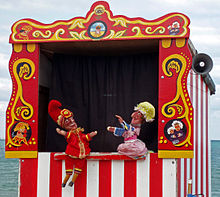
Back Poppekas Afrikaans مسرح الدمى Arabic مسرح العرائس ARZ Teatru de títeres AST Kukla Teatrı Azerbaijani Куклен театър Bulgarian পুতুল নাচ Bengali/Bangla Titelles Catalan Mŭk-ngēu-hié CDO Puppetry CEB
| Puppetry | |
|---|---|
 Punch & Judy puppet show at Swanage, Dorset, England | |
| Ancestor arts | Theatre |
| Originating era | 3000 BC |
| Part of a series on |
| Performing arts |
|---|
Puppetry is a form of theatre or performance that involves the manipulation of puppets – inanimate objects, often resembling some type of human or animal figure, that are animated or manipulated by a human called a puppeteer. Such a performance is also known as a puppet production. The script for a puppet production is called a puppet play. Puppeteers use movements from hands and arms to control devices such as rods or strings to move the body, head, limbs, and in some cases the mouth and eyes of the puppet. The puppeteer sometimes speaks in the voice of the character of the puppet, while at other times they perform to a recorded soundtrack.
There are many different varieties of puppets, and they are made of a wide range of materials, depending on their form and intended use. They can be extremely complex or very simple in their construction. The simplest puppets are finger puppets, which are tiny puppets that fit onto a single finger, and sock puppets, which are formed from a sock and operated by inserting one's hand inside the sock, with the opening and closing of the hand simulating the movement of the puppet's "mouth". A hand puppet or glove puppet is controlled by one hand which occupies the interior of the puppet and moves the puppet around. Punch and Judy puppets are familiar examples. Other hand or glove puppets are larger and require two puppeteers for each puppet. Japanese Bunraku puppets are an example of this. Marionettes are suspended and controlled by a number of strings, plus sometimes a central rod attached to a control bar held from above by the puppeteer. Rod puppets are made from a head attached to a central rod. Over the rod is a body form with arms attached controlled by separate rods. They have more movement possibilities as a consequence than a simple hand or glove puppet.
Puppetry is a very ancient form of theatre which was first recorded in the 5th century BC in Ancient Greece. Some forms of puppetry may have originated as long ago as 3000 years BC.[1] Puppetry takes many forms, but they all share the process of animating inanimate performing objects to tell a story. Puppetry occurs in almost all human societies where puppets are used for the purpose of entertainment through performance, as sacred objects in rituals, as symbolic effigies in celebrations such as carnivals, and as a catalyst for social and psychological change in transformative arts.[2]
- ^ Cite error: The named reference
blumenthalwas invoked but never defined (see the help page). - ^ Strings, Hands, Shadows: A Modern Puppet History, John Bell, Detroit Institute of Art, 2000, ISBN 0-89558-156-6